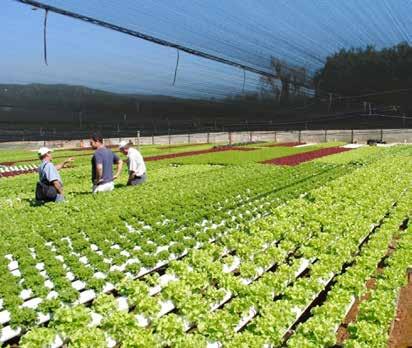
4 minute read
Shade net protects your valuable agricultural investment in many ways
Greenhouse farming initially entailed glass houses with hydroponics systems to pro-long the production cycle and obtain even quality, amongst others. When shade net production came into being for car ports and other usages, all of a sudden the fruit and vegetable production sectors got interested to apply shade nets over their greens, berries, table grapes, cherries, citrus, figs, flowers and nut trees.
Advertisement
PlusNet covering a hydroponics lettuce farm in the South Eastern Cape.
The producers mainly needed protection against the harsh South African sun, severe hail storms, wind chafing and birds. Greenhouse farming initially entailed glass houses with hydroponics systems to pro-long the production cycle and obtain even quality, amongst others. When shade net production came into being for car ports and other usages, all of a sudden the fruit and vegetable production sectors got interested to apply shade nets over their greens, berries, table grapes, cherries, citrus, figs, flowers and nut trees. The producers mainly needed protection against the harsh South African sun, severe hail storms, wind chafing and birds. Much research went in the different types and colours of shade net, as it has direct effect on the particular crop it covers. Today, PlusNet is one of the foremost shade net manufacturers that cater for agriculture, homes and even camping equipment. The percentage of a shade net denotes its translucency and its colour has an effect on a particular crop or application. PlusNet’s 40% shade net is specifically manufactured for the agricultural sector and is suitable for most vegetable types.

shade NeT proTecTs yoUr ValUable aGricUlTUral iNVesTMeNT 5
40% Black Shade net Palms • Cycads • Orchids • Pot Plants • Bedding Plants • Lillies 40% Titanium, White or Grey Lettuce Celery Spinach Cauliflower Broccoli Vegetable seedlings Herbs Tomatoes Peppers Paprika Peppadews Beans Melons Baby marrows Butternut Bedding Plants Nursery display Wind Breaks UV blockage of up to 22% and a shading of 12%. The Agri+ 20% white shade net is widely popular in the Western Cape region and is suitable for covering: • Lettuce • Celery • Apples • Grapes • Berries • Citrus • Avos
Disclaimer: Shade netting requirements will depend on plant cultivar, location and climatic conditions in a specific region. Please consult with Plusnet before purchasing to ensure that this product will be suitable for your geographic location.

PlusNet covering export table grape vineyards.
The darker the net, the more shade it provides. Most plants do not produce well under darker nets as there is diffused sunlight, therefore very little photosynthesis takes place which means little growth. Under a 40% net, depending on the colour, various types of fresh produce grow well and produce excellent.
Advantages of Undercover Fruit Farming
Covering orchards with low-percentage shade nets, like PlusNet’s 20% agricultural shade (3 Bar or 2 Bar) net can significantly improve the performance of the orchard / vineyard. Part of the responses can be attributed to the filtering of the light spectrum by the nets, and part is due to physical protection and creating a friendlier micro-climate. Improved external fruit quality is insured because of less sun burns and wind scars, smoother skin and better fruit colour. Furthermore, the low percentage shade nets reduce heat/chill stresses, offer enhanced photosynthesis and, importantly, better/less water usage. PlusNet products offer hazard Protection which include protection from excessive solar radiation, protection from environmental hazards (wind, hail, sandstorms and ice rain) and protection from flying pests (birds, fruit bats and insects). every roll of PlusNet shade net carries a ten year guarantee against sun degradation. For further information on your particular shade net requirements, please get in touch with PlusNet at 011-412 39 54 or at nets@plusnet.co.za
GreeNhoUse TechNoloGy For sUsTaiNabiliTy 4
These topics represent the principal limitations and consequences of protected agriculture to which technology seeks to provide a solution. Throughout the period of an analysis of study papers by researchers on GT(1999–2018), the concern about the above-mentioned topics is maintained; however, there has been a significant evolution in the technology developed in each of the aspects. even though at the beginning of the period, many studies focused on the distribution and design of lighting and ventilation systems, support of the structure, etc., currently there is a predominance of studies on automation systems, the development of sensors, the design of online applications, biological pest control, the genetic modification of crops, and more. A study was done on the variation trends in the number of articles published on GT, with that of the


Robot tomato harvesting system.
Climate, soil, irrigation and light control systems for distant greenhouse management.
number of articles published on agriculture in general. This revealed the number of articles on traditional agriculture has increased at an average annual rate of 0.4% between 1999 and 2018, while the articles on GT have grown by 1.1%. Therefore, it may be concluded that GT is a subject which has gained relevance in the research on agricultural production activities. Source: excerpts of a study on agricultural technology writers from the main agricultural production countries around the world, to acknowledge the increase in publicity for greenhouse technology trends and results. Authors: José A. Aznar-Sánchez, Juan F. VelascoMuñoz, Belén López-Felices and Isabel M. Román-Sánchez; Department of economy and Business, Research Centre on Mediterranean Intensive Agro Systems and Agri-food Biotechnology, University of Almería, Spain. Published January 2020.









